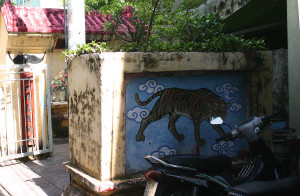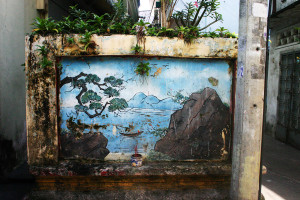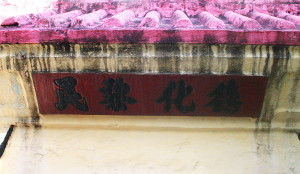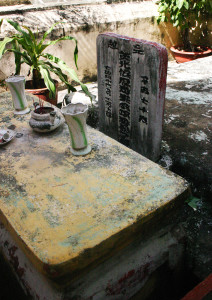
The Phan Tấn Huỳnh tomb at Hẻm 120 Huỳnh Văn Bánh in Phú Nhuận district
This article was published previously in Saigoneer http://saigoneer.com
Hidden away at the end of an alley in Phú Nhuận is the forgotten tomb of Marshal Lê Văn Duyệt’s deputy, Phan Tấn Huỳnh.

The tiger on the front face of the screen at the Phan Tấn Huỳnh tomb
Phan Tấn Huỳnh 潘晉黃 (1754-1824) was a royal mandarin who distinguished himself in the 1790s in the military service of Lord Nguyễn Phúc Ánh, later becoming a high-ranking official at Gia Định Citadel. His modest tomb, situated at the end of Hẻm 120 Huỳnh Văn Bánh in Phú Nhuận district, is housed within a small walled compound and concealed by a large screen.
The screen in front of Phan Tấn Huỳnh’s tomb features paintings of a tiger on the front and a coastal scene on the rear. The tomb itself is accessed by a small gate with an imitation traditional tube-tiled roof, above which are inscribed the Chinese characters 德化黎民 (Dé huà lí mín or Đức hóa lê dân, literally “Making the common people virtuous”). Twin sentences (câu đối) in Chinese on either side of the gate praise Phan Tấn Huỳnh’s great loyalty and service to his country.

The coastal scene on the rear face of the screen at the Phan Tấn Huỳnh tomb
Inside the tomb compound, there is an altar in front of the tomb, backed by a small stele bearing Phan Tấn Huỳnh’s names and titles. However, it is the eulogy – inscribed in Chinese characters on the rear screen behind the tomb – which tells us most about the man who was buried here nearly 200 years ago.
According to the eulogy, Phan Tấn Huỳnh (posthumous name Khiêm) was a descendant of one Phan Công Thiên, who migrated from Quảng Nam to Gia Ðịnh in the late 17th century. During the Nguyễn-Tây Sơn war, “having greater skill than others,” Huỳnh fought courageously in Nguyễn Phúc Ánh’s armies under such famous generals as Lê Văn Duyệt, Ngô Tùng Châu, Võ Tánh and Trương Tấn Bửu.

The Chinese characters 德化黎民 (Dé huà lí mín or Đức hóa lê dân, literally “Making the common people virtuous”) above the gate of the Phan Tấn Huỳnh tomb
In 1802, after Nguyễn Phúc Ánh took the throne as King Gia Long, Phan Tấn Huỳnh was granted the honorary title Hoàng Ngọc Hầu. Then in 1807, he himself became a General and High-ranking Special Envoy, charged with assisting Marshal Lê Văn Duyệt in his duties as Governor of Gia Định.
Phan Tấn Huỳnh distinguished himself in battle again in 1809-1816, when he served as deputy commander of a long campaign against rebel forces in Quảng Ngãi.
In 1820, he became Divisional Commander of Phiên An (Bến Nghé, now Saigon), and “over the next two years, all of the documents of Marshal Lê Văn Duyệt were drafted by his hand.” During this period, he also promoted the colonisation of new land in Gia Định by offering incentives to Việt settlers.

In front of the tomb is an altar and a small stele bearing Phan Tấn Huỳnh’s names and titles
In 1822, Phan Tấn Huỳnh’s health began to deteriorate due to old age and he was permitted to retire on an official pension. However, the eulogy tells us that just two years later, “for reasons of poor health and severe illness, he did not want to become an encumbrance to his children, so he committed suicide to free himself from suffering, on the 11th day of the 11th lunar month in the fifth year of King Minh Mạng (1824).”
Not yet recognised as a heritage site, the Phan Tấn Huỳnh Tomb is currently cared for by a local family, though sadly, few of the other residents of Hẻm 120 seem to have any knowledge of the great royal mandarin buried in their midst.
You may also be interested to read these articles:
Forgotten Nguyen Dynasty Tombs of Phu Nhuan
Ancient Tombs of Saigon – Lam Tam Lang Tomb, 1841
Ta Duong Minh – Thu Duc’s Founding Father 1860s

Behind the tomb is a large screen inscribed with Chinese characters which recount Phan Tiến Huỳnh’s distinguished career.
Tim Doling is the author of the guidebook Exploring Saigon-Chợ Lớn – Vanishing heritage of Hồ Chí Minh City (Nhà Xuất Bản Thế Giới, Hà Nội, 2019)
A full index of all Tim’s blog articles since November 2013 is now available here.
Join the Facebook group pages Saigon-Chợ Lớn Then & Now to see historic photographs juxtaposed with new ones taken in the same locations, and Đài Quan sát Di sản Sài Gòn – Saigon Heritage Observatory for up-to-date information on conservation issues in Saigon and Chợ Lớn.

